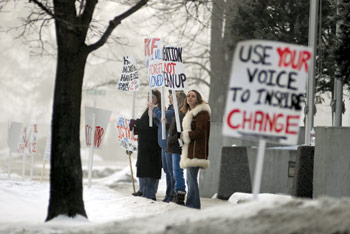On Feb. 2 in Whitefish, Katherine Lanegan of Whitefish shot and killed her boyfriend, Ordean L. Engebretson, in what police said was likely a case of self-defense. A little more than a month later, Wayne C. Bengston would shoot and kill his wife’s friend Gregory G. Rodriguez in the same town.
Whitefish Police Chief Bill Dial said it was the most violent month Whitefish has seen in his 11-year tenure as chief, and hoped the bloodshed was over.
But, as the investigations into the deaths continue, the conversation has turned to domestic violence, which investigators think was part of the reason behind both of the killings. Dial said his officers deal with plenty of domestic violence cases each year, and the recent deaths provide a compelling reason to make it a public conversation.
“When you talk to people who are victims of domestic violence, you find out this probably happened four or five times before they called,” Dial said in an interview last week. “We need to get people to know that there’s resources out there.”
Dial said one of the most common reasons domestic violence victims don’t ask for help is that they are under the impression the abuse is somehow their fault. That cycle of thinking has to be broken, he said.
“I’ve seen it happen a lot. I’ve seen people, professional people, doctors, attorneys, say to me or my officers, ‘Well I shouldn’t have said that to him or her,’” Dial said. “That’s no reason to hit anyone.”
Hilary Shaw, executive director of the Abbie Shelter and the Violence Free Crisis Line, said situations that end in someone being killed often catch the public’s attention, but that the public is often unaware that such a violent act is typically the end of a long string of abuse.
Domestic violence is not a “crime of passion,” Shaw said. It is planned and premeditated.
“It’s the ultimate act of control,” Shaw said. “It typically happens when an abuser feels (they have) nothing left to lose.”
The threat of homicide increases when a domestic violence victim attempts to leave an abusive relationship, Shaw said, which may be one of the factors why the victim stays in the cycle.
According to a 2010 survey from the Center for Disease Control, one in four women has been the victim of severe physical violence by an intimate partner, and the same is true for one of every six men.
While domestic violence is not uncommon, Shaw said there is only so much her organization can do if the victims do not reach out for help.
“All of the homicides that have happened while I’ve been working here and the ones that I’ve looked back on, the victims have never contacted us before,” Shaw said.
Dial also expressed frustration that there is only so much that the police can do if the abuse is not reported, either by the victim or their friends, coworkers or neighbors.
The reluctance to report or ask about someone else’s abuse can stem from feeling like it’s rude to invade the victim’s privacy, Dial said, or the fear that the abuser would turn their attentions to the party reporting the behavior.
 |
|
Sarah Peters, right, stands outside the Flathead County Justice Center with a group of women holding signs bringing attention to issues of domestic violence in light of her former husband, Justin Calbick’s, domestic homicide case in 2011. – File photo by Lido Vizzutti | Flathead Beacon |
But when those who need the most help can’t find their voice, it’s the community’s job to help them reclaim it. Dial said domestic violence is a community disease, not something confined to the couple. Anyone can call the police and report it anonymously, he added.
“It should be everybody’s business,” Dial said. “If you live next to somebody and you constantly hear someone screaming or getting hurt, call the police.”
Shaw said the community’s responsibility is to notice and ask. Though it might be a tough conversation to have with someone, she said, just having it reassures the victim that they are not alone, not invisible.
“It needs to be done with tenderness and a complete lack of judgment,” Shaw said.
The community also needs to be educated on domestic violence, Shaw said, and that starts with the children. Shaw teaches hundreds of middle school and high school students about relationship violence each year, and though the curriculum for educating girls seems to be in place, education for boys is lacking, she said.
Domestic violence is a learned behavior, Shaw said, and more boys and men need to be taught that reacting in violence is not natural, acceptable or legal.
Dial agreed, saying that kids usually learn violent behavior from their parents.
“We’ve got to break the cycle,” Dial said. “You’ve got to teach them it’s not acceptable.”
DOMESTIC VIOLENCE RESOURCES
The Violence Free Crisis Line: (406) 752-7273; www.violencefreecrisisline.org
National Coalition Against Domestic Violence: www.ncadv.org
Montana Coalition Against Domestic Violence: www.mcadv.org
RAINN – Rape, Abuse, and Incest National Network: www.rainn.org